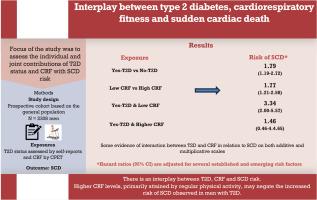The Interplay of Type 2 Diabetes Status, Cardiorespiratory Fitness Level, and Sudden Cardiac Death: A Prospective Cohort Study
IF 2.5
Q2 CARDIAC & CARDIOVASCULAR SYSTEMS
引用次数: 0
Abstract
Background
To evaluate the individual and joint effects of type 2 diabetes (T2D) status and cardiorespiratory fitness (CRF) level with sudden cardiac death (SCD) risk.
Methods
Prevalent T2D was defined based on guideline recommendations, and CRF level was assessed using a respiratory gas-exchange analyzer during exercise testing at baseline, in 2308 men aged 42-61 years. T2D status was classified as either “Yes” or “No,” and CRF level was classified as low, medium, or high. Cox regression analysis was used to estimate hazard ratios (HRs) with 95% confidence intervals (CIs) for SCD.
Results
A total of 264 SCDs occurred during a median follow-up of 28.1 years. Comparing Yes vs No history of T2D, the multivariable-adjusted HR (95% CI) for SCD was 1.79 (1.19-2.72). Comparing low vs high CRF levels, the corresponding adjusted HR (95% CI) for SCD was 1.77 (1.21-2.58). The HRs persisted when T2D status was further adjusted for CRF level, and vice versa. Compared with No-T2D & medium-high CRF level, men with No-T2D & low CRF and those with Yes-T2D & low CRF had an increased SCD risk: (HR = 1.87, 95% CI, 1.38-2.55) and (HR = 3.34, 95% CI, 2.00-5.57), respectively. No significant association occurred between men with Yes-T2D & medium-high CRF and SCD risk (HR = 1.46, 95% CI, 0.46-4.65). Modest evidence indicated the presence of additive and multiplicative interactions between T2D status and CRF level, in relation to SCD.
Conclusions
An interplay exists between T2D status, CRF level, and SCD risk in middle-aged and older men. Higher CRF levels may mitigate the increased SCD risk observed in men with T2D.

2 型糖尿病状态、心肺功能水平与心脏性猝死的相互作用:一项前瞻性队列研究
背景为了评估 2 型糖尿病(T2D)状态和心肺功能(CRF)水平对心脏性猝死(SCD)风险的个体和联合影响,我们对 2308 名 42-61 岁的男性进行了调查。T2D状态分为 "是 "或 "否",CRF水平分为低、中或高。结果 在中位 28.1 年的随访期间,共发生了 264 例 SCD。比较有与无 T2D 病史,SCD 的多变量调整 HR(95% CI)为 1.79(1.19-2.72)。比较低 CRF 水平与高 CRF 水平,SCD 的相应调整 HR(95% CI)为 1.77(1.21-2.58)。当进一步调整T2D状态和CRF水平时,HRs仍然存在,反之亦然。与No-T2D & 中高CRF水平相比,No-T2D & 低CRF和Yes-T2D & 低CRF男性的SCD风险增加:分别为(HR = 1.87,95% CI,1.38-2.55)和(HR = 3.34,95% CI,2.00-5.57)。在Yes-T2D & 中高CRF的男性与SCD风险之间无明显关联(HR = 1.46, 95% CI, 0.46-4.65)。适度的证据表明,T2D 状态和 CRF 水平与 SCD 之间存在相加和相乘的相互作用。较高的 CRF 水平可减轻 T2D 男性患者 SCD 风险的增加。
本文章由计算机程序翻译,如有差异,请以英文原文为准。
求助全文
约1分钟内获得全文
求助全文
来源期刊

CJC Open
Medicine-Cardiology and Cardiovascular Medicine
CiteScore
3.30
自引率
0.00%
发文量
143
审稿时长
60 days
 求助内容:
求助内容: 应助结果提醒方式:
应助结果提醒方式:


